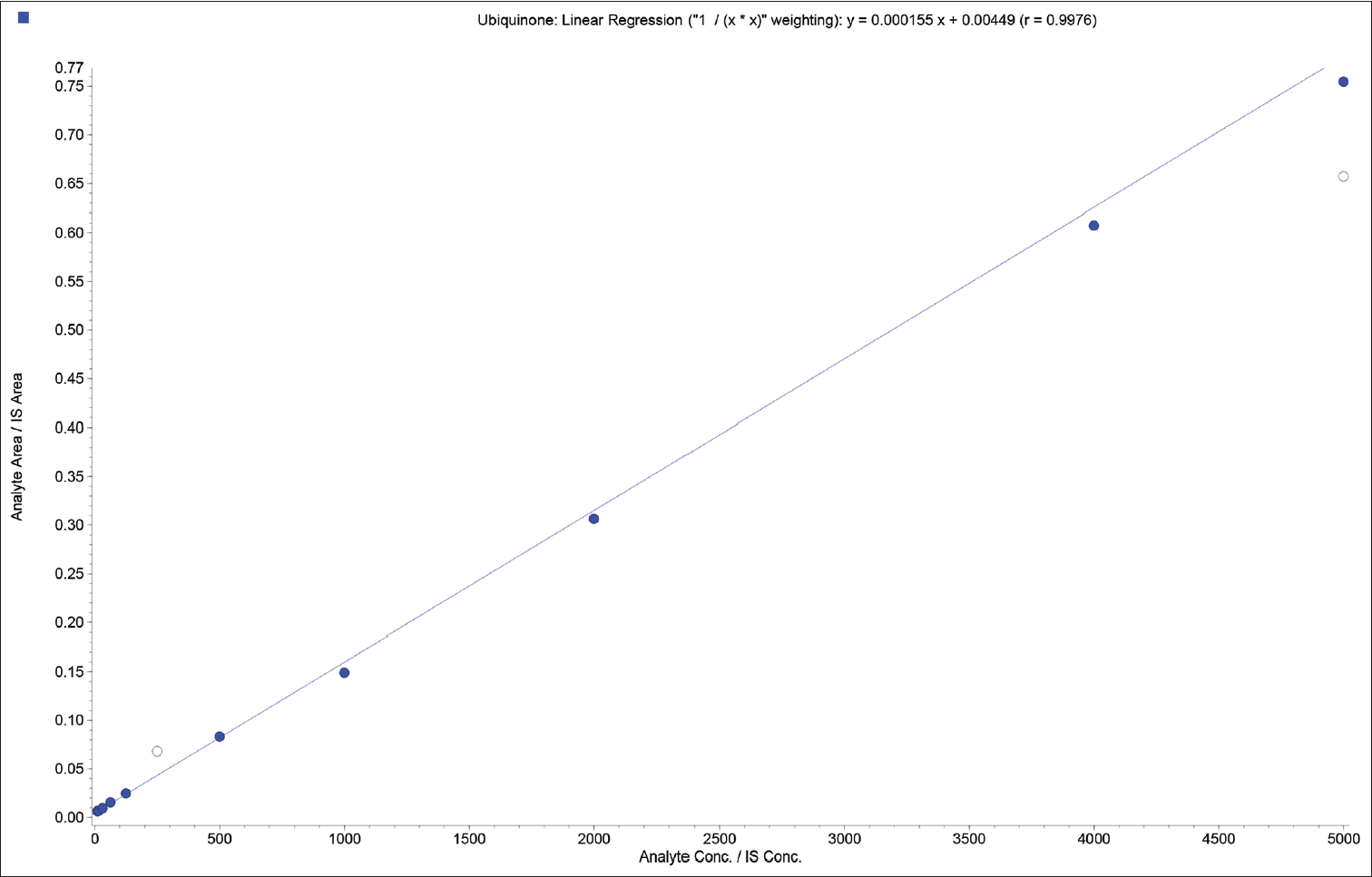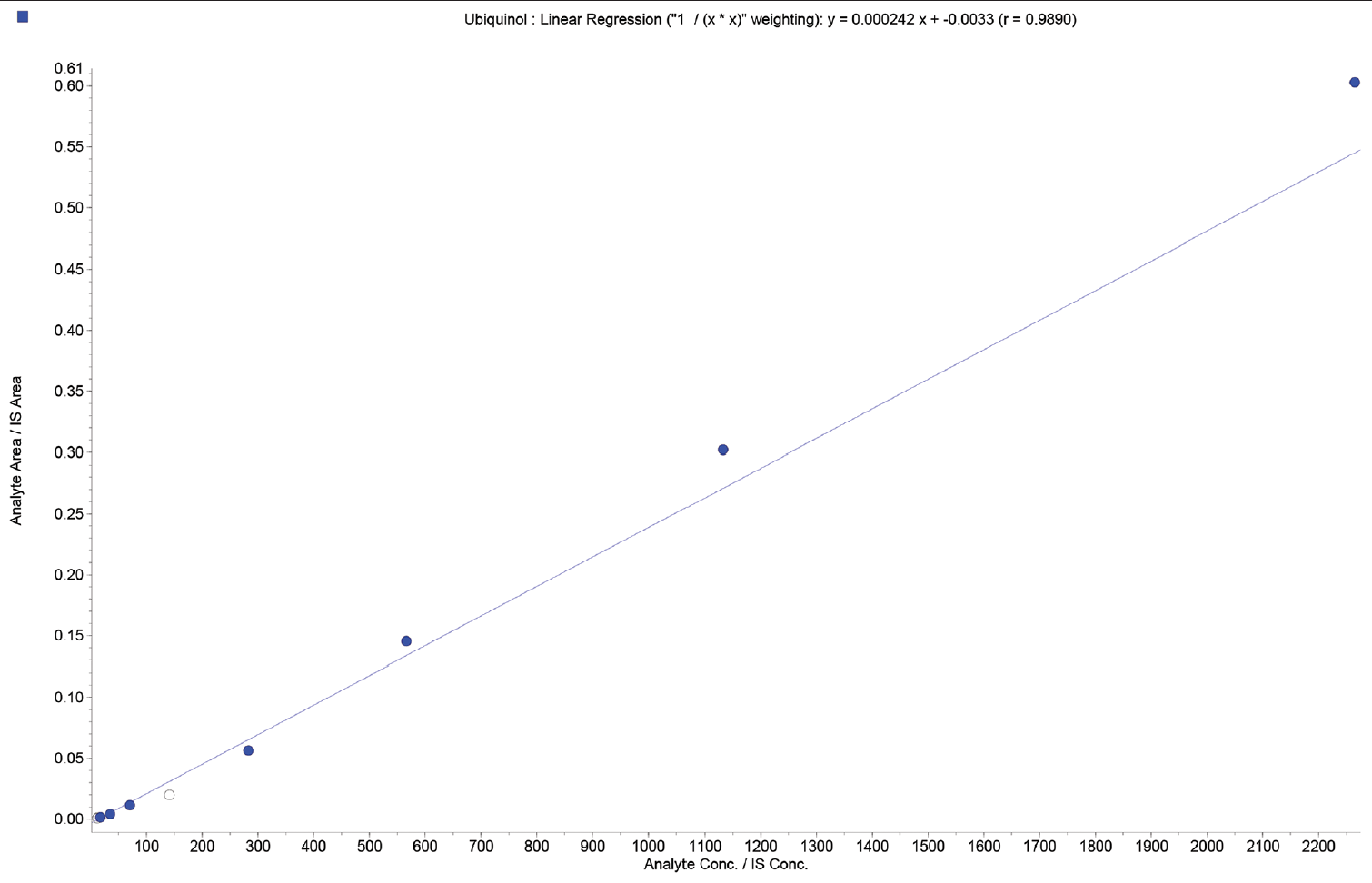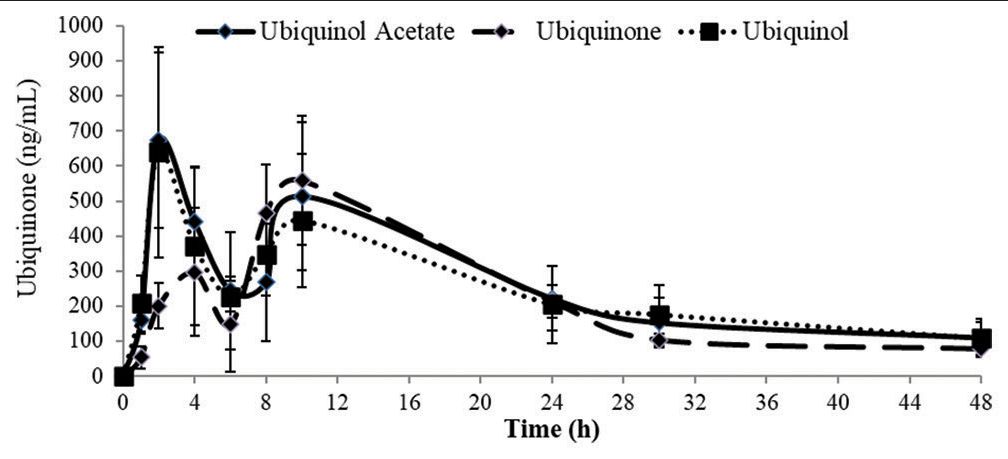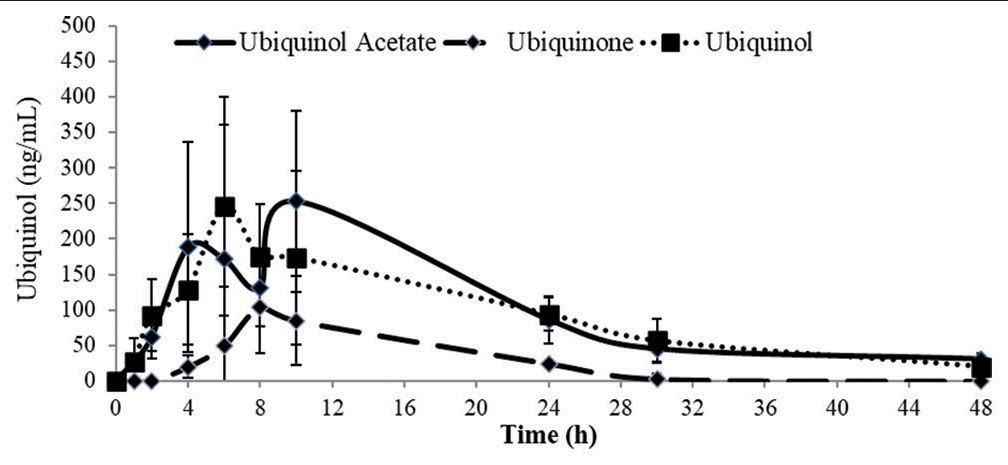Translate this page into:
Evaluation of pharmacokinetic parameters of ubiquinol acetate, ubiquinone and ubiquinol in male Sprague-Dawley rats – A comparative study
*Corresponding author: Geetha Kannoth Mukundan, Department of Pharmacology, College of Pharmaceutical Sciences, Dayananda Sagar University, Bengaluru, Karnataka, India. geetha-sps@dsu.edu.in
-
Received: ,
Accepted: ,
How to cite this article: Umesh MC, Mukundan GK, Seekallu S. Evaluation of pharmacokinetic parameters of ubiquinol acetate, ubiquinone and ubiquinol in male Sprague-Dawley rats – A comparative study. Indian J Physiol Pharmacol 2023;67:191-6.
Abstract
Objectives:
The objective of this study was to evaluate single-dose oral comparative pharmacokinetics studies of ubiquinol acetate (EnQ10), ubiquinone and ubiquinol in male Sprague-Dawley (SD) rats.
Materials and Methods:
Oral suspension formulations of ubiquinol acetate (EnQ10), ubiquinone, and ubiquinol at 300 mg/kg body weight (equivalent dose of ubiquinone) were prepared in 0.1% (v/v) Tween 80 and 15% (w/v) hydroxypropyl-α-cyclodextrin. Six animals per group for each compound were dosed with oral suspension formulations of EnQ10, ubiquinone, and ubiquinol. Blood samples were collected at time points of 1, 2, 4, 6, 8, 10, 24, 30, and 48 h and plasma samples were analysed using liquid chromatography with tandem mass spectrometry for the analyte’s ubiquinone and ubiquinol.
Results:
In EnQ10 dosed animals, the plasma mean concentration maximum, Cmax (347.83 ng/mL) of ubiquinol was found to be 2.52 times higher versus ubiquinone dosed animals (137.90 ng/mL). Furthermore, in EnQ10 dosed animals, the observed plasma exposure (AUClast) (4808.94 h*ng/mL) for ubiquinol was found to be 3.96 times higher versus. Ubiquinone dosed animals (1214.42 h*ng/mL). One-way ANOVA (Analysis of Variance) was performed for the Cmax and AUClast of ubiquinol. There was a significant increase (P < 0.05) in the Cmax and AUClast of ubiquinol in animals dosed with EnQ10 compared to the animals dosed with ubiquinone.
Conclusion:
The findings from this study indicated that ubiquinol acetate (EnQ10) showed better oral bioavailability compared to ubiquinone (CoQ10) when administered orally (300 mg/kg body weight equivalent dose of ubiquinone) in the male in male SD Rats.
Keywords
Coenzyme Q10
CoQ10
EnQ10
Ubiquinol
Ubiquinone
Ubiquinol acetate
INTRODUCTION
Coenzyme Q10 (CoQ10) is a natural, lipid soluble and vitamin-like endogenous antioxidant. It is majorly present in organs such as heart, liver and kidney. In elder age, level of CoQ10 synthesis will be reduced. Depletion levels of CoQ10 in body are associated with aging and several age-related pathologies. Hence, CoQ10 has been used as a dietary supplement in humans. CoQ10 is proved to be a medical agent for treating cardiovascular diseases based on its fundamental role in mitochondrial function and cellular bioenergetics.[1,2] CoQ10 mainly present in two forms ubiquinone (inactive, oxidised form of CoQ10) and ubiquinol (active, reduced form of CoQ10). Human body converts ubiquinone into the active form, ubiquinol which is body’s preferred form of CoQ10.[3,4]
Most of CoQ10 supplements contain ubiquinone because ubiquinol is unstable and easily converts back into ubiquinone when exposed to air.[5] Ubiquinol acetate (EnQ10) is a stable novel antioxidant developed in recent days. Recent studies have proved that EnQ10 is more stable and biologically active. Furthermore, synthesised ubiquinol acetate showed better stability than that of ubiquinol at the end of 3 months.[6] Hence, understanding the oral pharmacokinetics (PKs) of ubiquinol acetate (EnQ10) is required in comparison with ubiquinone and ubiquinol.
MATERIALS AND METHODS
Test compounds
The test compounds, ubiquinol acetate (Source: Anthem Biosciences Pvt. Ltd.; Batch No.: A21600497; Purity: 99.1%) ubiquinone (Source: Kingdomway; Batch No: 51-175102; Purity: 100.10%) and ubiquinol (Source: Anthem Biosciences Pvt. Ltd.; Batch No.: A011809898; Purity: 98.42%) used in the present study were collected from Department of Chemistry, Anthem Biosciences Pvt. Ltd, Bengaluru, India.
Materials and chemicals
Hydroxypropyl-α-cyclodextrin (catalogue no. H0979; TCI chemicals); Tween 80 (catalogue no. P1754; Sigma-Aldrich); isoflurane USP (Raman and Weil Pvt Ltd); dipotassium ethylenediaminetetraacetate (catalogue no. RANKE2014; Rankem); tert-butyl methyl ether (catalogue no. RANKM2500; Rankem); formic acid (catalogue no. F0507; Sigma Aldrich) and 2-propanol (catalogue no. RANKP0792; Rankem).
Test system
Male Sprague-Dawley (SD) weighing around 250–300 g obtained from Hylasco Biotechnology (India) Pvt Ltd was used for this study. This study was approved by the Institutional Animal Ethical Committee (IAEC) with approval number which is ABD/IAEC/PR/89-17-20.
Rats were freely accessible to food and water during the quarantine period. Rats were fasted for 12 h and allowed free access to water before the experiments. All rats were processed according to suggested ethical guidelines for the care of laboratory animals.
Formulation preparation
Ubiquinol acetate, ubiquinone, and ubiquinol oral formulations were prepared using 0.1% (v/v) Tween 80 and 99.9% (v/v) of 15 % (w/v) hydroxypropyl-α-cyclodextrin in water. The formulations were prepared by trituration using mortar and pestle to obtain uniform suspension formulations of 60 mg/ mL strength (Dose: 300 mg/kg body weight, equivalent dose of ubiquinone; Dose volume: 5 mL/kg body weight).
PK study
All SD rats were randomly divided into three groups (G1, G2, and G3) with 6 animals per group. Six fasted animals per group for each compound ubiquinol acetate (G1), ubiquinone (G2), and ubiquinol (G3) were dosed with oral suspension formulations (60 mg/mL equivalent to ubiquinone). The blood samples were collected in K2EDTA tubes and plasma samples were harvested at time points of 0 (pre-dose), 1, 2, 4, 6, 8, 10, 24, 30, and 48 h. Then, the plasma samples were analysed using API 3200 Q-trap liquid chromatography with a tandem mass spectrometry system for the analyte’s ubiquinone and ubiquinol.
Instruments and conditions
A sensitive high-performance liquid chromatography (HPLC) coupled with a triple-quadrupole mass spectrometry method was developed for the quantification of ubiquinone and ubiquinol in rat plasma using the liquid-liquid extraction (LLE) method.
Liquid-liquid extraction
Plasma samples (100 µL) were added with 10 µL of internal standard working solution (10 µg/mL) in extraction tubes. About 2.5 mL extraction solvent; an equal mixture of isopropyl alcohol and tertiary butyl methyl ether (1:1) was added and kept for mixing for 10 min in a vibromax shaker and then centrifuged at 10,000 rpm at a set temperature of 10°C. Exactly, 2 mL of supernatant was evaporated (45°C) to dryness using a nitrogen turbo evaporator. The dried samples were reconstituted with 200 µL of Mobile phase (1:1 2-Propanol (IPA): 5mM ammonium formate in methanol). Chromatographic separation was achieved on a Venusil XBP (broad pH range) C18 (4.6 mm × 50 mm, 3.0 µm) column with 0.1% formic acid in isopropyl alcohol and 5 mM ammonium formate in methanol as mobile phase with isocratic elution. The flow rate was set at 0.700 mL min−1. The detection was accomplished by a triple-quadrupole tandem mass spectrometry in multiple-reaction monitoring scanning through an electrospray ionization source in the positive mode. The optimised mass transition ion pairs (m/z) for quantitation were m/z 880.698/197.100 for ubiquinone, m/z 882.700/197.000 for ubiquinol, and m/z 376.165/165.100 for internal standard (Haloperidol).
Linearity curve in rat plasma
The calibration range for ubiquinone and ubiquinol in rat plasma was prepared according to the concentrations anticipated in the plasma samples to be determined. The calibration curve range of 10.937–4999.995 ng/mL for ubiquinone and 17.699–2265.500 ng/mL for ubiquinol in rat plasma were prepared by spiking blank rat plasma with respective aqueous analyte standards.
| LC parameters | |
| Column | Venusil XBP C18 (4.6 mm×50 mm, 3.0 μm) |
| Mobile phase | 0.1% Formic acid in IPA: 5mM ammonium formate in methanol (45:55% v/v) |
| Separation mode | Isocratic |
| Flow rate | 0.700 mL/min |
| Injection volume | 10 µL |
| Autosampler temperature | 10°C |
| Column oven temperature | 40°C |
| MS parameters | |
| LC-MS | API 3200 Q Trap |
| Source | Turbo ion spray |
| Polarity | Positive |
| m/z of Ubiquinone [M+NH4]+ | 880.698→197.100 |
| m/z of Ubiquinol [M+NH4]+ | 882.700→197.000 |
| m/z of IS (Haloperidol) | 376.165→165.100 |
LC-MS: Liquid chromatography-mass spectrometry, API: Atmospheric pressure ionization
PK analysis
The non-compartmental PK model was carried out using the Phoenix WinNonlin 6.3 software. The PK parameters including the area under the curve (AUC) of plasma concentration versus time, the maximum concentration (Cmax) recorded, the time taken to reach Cmax (Tmax), the half-life of elimination (t½), and the mean residential time were determined.
Statistical analysis
Statistical analysis was performed on the results by one-way analysis of variance (ANOVA) to compare the Cmax and AUClast of ubiquinol (analyte) in all dosed groups using GraphPad Prism 5.0 statistical software package. The significance level was chosen at P < 0.05 for all statistical analyses in comparison to all dosed groups.
RESULTS
In this study, calibration plots were linear over the range of 10.937–4999.995 ng/mL for ubiquinone [Figure 1] and 17.699–2265.500 ng/mL for ubiquinol [Figure 2] in rat plasma. The linearity coefficient (r) for ubiquinone and ubiquinol was >0.98 and lower limit of quantification level was 10.937 ng/ mL for ubiquinone and 17.669 ng/ml for ubiquinol. This developed method was successfully used in the PK studies for the identification of ubiquinone and ubiquinol in rat plasma.

- Calibration curve for ubiquinone in rat plasma (10.937–4999.995 ng/mL). PK: Pharmacokinetics, IS: Internal standard.

- Calibration curve for ubiquinol in rat plasma (17.699–2265.500 ng/mL). PK: Pharmacokinetics, IS: Internal standard.
The plasma concentrations of ubiquinone and ubiquinol over the time course after oral administration of ubiquinol acetate, ubiquinone, and ubiquinol are shown in [Graph 1 and Graph 2]. The summary of PK parameters of ubiquinone and ubiquinol are shown in [Table 1]. The summary of statistical analysis results are shown in [Table 2 and Graph 3].

- Time-course of plasma ubiquinone after oral administration of ubiquinol acetate, ubiquinone and ubiquinol in male Sprague-Dawley rats.

- Time-course of plasma ubiquinol after oral administration of ubiquinol acetate, ubiquinone, and ubiquinol in male Sprague-Dawley rats.

- Statistical analysis by one-way analysis of variance for ubiquinol Cmax and AUClast after dose administration of ubiquinol acetate, ubiquinone, and ubiquinol in male Sprague-Dawley rats. (a) Cmax of ubiquinol and (b) AUClast of ubiquinol. PK= Pharmacokinetics, AUC=Area under curve (AUC, h*ng/mL), Cmax = Concentration maximum (Cmax, ng/mL).
| Parameters | Ubiquinone (analyte) | Ubiquinol (analyte) | ||||
|---|---|---|---|---|---|---|
| Ubiquinol acetate | Ubiquinone | Ubiquinol | Ubiquinol acetate | Ubiquinone | Ubiquinol | |
| Cmax(ng/mL) | 800.27±136.70 | 600.63±173.16 | 656.44±283.29 | 347.84±127.21 | 137.91±70.42 | 319.68±134.97 |
| Tmax (h) | 4.67±4.13 | 9.33±1.03 | 3.33±3.27 | 7.67±2.66 | 8.333±1.51 | 7.67±1.97 |
| AUClast (h*ng/mL) | 12248.01±1697.68 | 10746.57±2235.79 | 11755.37±3966.81 | 4808.94±602.45 | 1214.42±608.39 | 4344.55±1489.48 |
| AUCinf (h*ng/mL) | 15687.254±3686.53 | 12284.54±2518.40 | 14884.39±5319.77 | 5397.06±653.41 | 1700.00±381.47 | 4985.73±1623.48 |
| AUCextrap (%) | 20.36±9.72 | 12.64±2.47 | 20.70±4.55 | 10.93±2.74 | 32.00±23.510 | 13.20±5.00 |
| t1/2 (h) | 20.55±5.63 | 13.57±1.24 | 19.93±3.46 | 13.35±1.610 | 13.61±7.561 | 13.98±1.53 |
| MRTlast(h) | 17.14±1.58 | 16.87±0.97 | 17.67±2.30 | 16.04±2.32 | 12.00±1.76 | 15.49±2.61 |
SD: Sprague-Dawley, AUC: Area under curve (h*ng/mL), Cmax: Concentration maximum (ng/mL), n: Number of animals, Tmax: Peak Plasma Time (h), t1/2: Half-life (h), MRTlast: Mean residence time (h)
| PK parameters | Ubiquinol acetate | Ubiquinone | Ubiquinol | |||
|---|---|---|---|---|---|---|
| Ubiquinone | Ubiquinol | Ubiquinone | Ubiquinol | Ubiquinone | Ubiquinol | |
| Cmax(ng/mL) | 800.27 | 347.84b* | 600.63 | 137.90a* | 656.44 | 319.68 |
| AUClast (h*ng/mL) | 12248.01 | 4808.94b*** | 10746.57 | 1214.42a*** | 11755.37 | 4344.55 |
a* the Cmax (ng/mL) in bold value was found to be statistically significant (P<0.05) compared to of ubiquinol versus ubiquinone. b* the Cmax (ng/mL) in bold value was found to be statistically significant (P<0.05) compared to of ubiquinol acetate versus ubiquinone. a*** the AUClast (h*ng/mL) in bold value was found to be statistically significant (P<0.05) compared to of ubiquinol versus ubiquinone. b*** the AUClast (h*ng/mL) in bold value was found to be statistically significant (P<0.05) compared to of ubiquinol acetate versus ubiquinone, SD: Sprague-Dawley, AUC: Area under curve (h*ng/mL), Cmax: Concentration maximum (ng/mL), PK: Pharmacokinetics
DISCUSSION
Ubiquinol is an essential antioxidant required for human body for various health benefits. CoQ10 in the form of ubiquinone and ubiquinol is available in various brands in the market. Ubiquinone (CoQ10) has been on the market for closer to 40 years, whereas ubiquinol has only been around since 2007.[10]
Studies suggest that ubiquinol has superior bioavailability than ubiquinone (CoQ10) because it accounts for 90% of the CoQ10 that’s in the blood. Although ubiquinol has more health benefits as an antioxidant, it is known for its chemical instability and is rapidly oxidised to ubiquinone in atmospheric oxygen.[6] Hence, in recent years, efforts have been made to develop a stable form of ubiquinol. Recent studies have proved the chemical stability of novel antioxidant ubiquinol acetate (EnQ10).
Many bioanalytical techniques have been developed for the quantification of ubiquinone and ubiquinol in plasma/serum by HPLC, ultra-performance liquid chromatography, and liquid chromatography-mass spectrometry methods. These methods showed good linearity, precision, accuracy, and recovery in biological matrices.[7-9]
Based on the study results, oral PK studies of ubiquinol acetate, ubiquinone, and ubiquinol in male SD rats showed that the Cmax (347.83 ng/mL) for ubiquinol (active form) was found to be 2.52 times higher in the animals dosed with ubiquinol acetate (EnQ10) compared to animals dosed with ubiquinone (137.90 ng/mL). The mean plasma exposure AUClast (4808.94 h*ng/mL) for ubiquinol was found to be 3.96 times higher in the animals dosed with ubiquinol acetate compared to animals dosed with ubiquinone (1214.42 h*ng/mL). Statistical analysis was performed by one-way ANOVA for ubiquinol Cmax and AUClast in animals dosed groups.
CONCLUSION
Based on the obtained results, it was concluded that Ubiquinol acetate (EnQ10) showed better oral bioavailability compared to Ubiquinone (CoQ10) when administered orally in male SD Rats.
Acknowledgments
The authors like to acknowledge the Dean and the management of the College of Pharmaceutical Sciences, Dayananda Sagar University, Bengaluru for their support in carrying out this work and the Department of Chemistry, Anthem Biosciences Pvt. Ltd., Bengaluru, India, for supplying the test compounds (Ubiquinol aceate, Ubiquinone and Ubiquinol) which was used in this study.
Declaration of patient consent
The authors certify that they have obtained all appropriate consent.
Conflicts of interest
There are no conflicts of interest.
Use of artificial intelligence (AI)-assisted technology for manuscript preparation
The author(s) confirms that there was no use of artificial intelligence (AI)-assisted technology for assisting in the writing or editing of the manuscript and no images were manipulated using AI.
Financial support and sponsorship
Nil.
References
- Pharmacokinetic profiles of coenzyme Q10: Absorption of three different oral formulations in rats. J Health Sci. 2009;55:540-8.
- [CrossRef] [Google Scholar]
- Coenzyme Q and its role in the dietary therapy against aging. Molecules. 2016;21:373.
- [CrossRef] [PubMed] [Google Scholar]
- Food content of ubiquinol-10 and ubiquinone-10 in the Japanese diet. J Food Composit Anal. 2008;21:199-210.
- [CrossRef] [Google Scholar]
- Coenzymes Q9 and Q10: Contents in foods and dietary intake. J Food Composit Anal. 2001;14:409-17.
- [CrossRef] [Google Scholar]
- Study on safety and bioavailability of ubiquinol (Kaneka QH™) after single and 4-week multiple oral administration to healthy volunteers. Regul Toxicol Pharmacol. 2007;47:19-28.
- [CrossRef] [PubMed] [Google Scholar]
- Safety assessment of ubiquinol acetate: Subchronic toxicity and genotoxicity studies. J Toxicol. 2019;2019:3680757.
- [CrossRef] [PubMed] [Google Scholar]
- Analysis of CoQ10 in rat serum by ultra-performance liquid chromatography mass spectrometry after oral administration. J Pharm Biomed Anal. 2008;46:137-42.
- [CrossRef] [PubMed] [Google Scholar]
- HPLC analysis of reduced and oxidized coenzyme Q10 in human plasma. Clin Chem. 2001;47:256-65.
- [CrossRef] [PubMed] [Google Scholar]
- Relative Bioavailability of two forms of a novel water-soluble coenzyme Q10. Ann Nutr Metab. 2008;52:281-7.
- [CrossRef] [PubMed] [Google Scholar]
- Coenzyme Q10 In: Wolinsky I, Driskell JA, eds. Nutritional ergogenic aids. London, UK: CRC Press; 2004. p. :355-78.
- [CrossRef] [Google Scholar]






